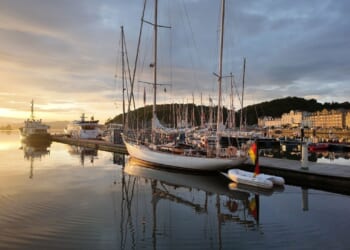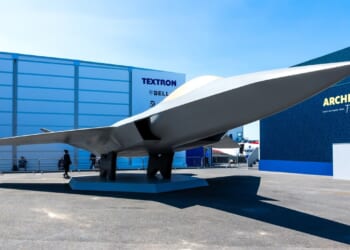The Pentagon has been warning since 2022 that the US desperately needed more icebreaker ships.
The United States Coast Guard commissioned a vessel last weekend that could be crucial to US military operations in the Arctic region. The Coast Guard, which operates under the Department of Homeland Security (DHS), but supports the US Navy, added the first polar icebreaker to its fleet in 25 years.
The former oilfield supply ship and icebreaking offshore tug Aiviq was re-commissioned on Sunday in a ceremony in Juneau, Alaska, as the USCGC Storis (WAGB-21).
“Storis adds vital capability to the U.S. polar icebreaker fleet at a critical time when our adversaries are expanding their activities in and near U.S. waters,” said Coast Guard commandant Adm. Kevin Lunday, USNI News reported.
The vessel was acquired by the Coast Guard last December and spent the first half of 2025 undergoing modifications that enhanced its communication and defense capabilities. USCGC Storis will expand America’s “operational presence in the Arctic.” At the same time, it further supports USCG missions as the service waits for “delivery of the new Polar Security Cutter class,” the USCGC explained.
America’s Adversaries Are Staking Their Claim in the Arctic
The Pentagon has been warning since 2022 that the United States desperately needed more icebreaker ships. Even as the ice has been melting in the great white North, icebreakers are still required for America to have year-round access to what is likely to be an increasingly contested region.
Until this month, the USCG operated just two aging icebreakers, and the shortage was noteworthy last year when USCGC Healy (WAGB-20), the largest and most technologically advanced icebreaker, was sidelined after suffering an electrical fire. That forced the cancellation of two scientific missions to the Arctic via the Northwest Passage.
The Coast Guard’s other icebreaker, USCGC Polar Star (WAGB-10), is tasked with traveling to McMurdo Station, Antarctica, annually. Both of those vessels are home ported in Seattle, as will be USCGC Storis, albeit temporarily. It was a year ago that the Coast Guard announced that Juneau would be the home port for the new icebreaker, along with the future fleet of such vessels as they enter service.
The first Polar Security Cutter, USCGC Polar Sentinel (PSC-1), is now being built by Bollinger in Louisiana and is scheduled for delivery in 2028. As that vessel is running three years late, the USCG opted to purchase the former icebreaking offshore tug Aiviq as a stopgap to bridge the delay.
The Trump administration has also approved a budget measure that will see $300 million directed towards improving the Coast Guard facilities in Juneau. However, construction has yet to begin.
What Are the Capabilities of the Storis?
WAGB-21 is the second Coast Guard vessel named for the “Galloping Ghost of the Alaskan Coast.” The previous USCGC Storis (WAGL-38) served with the USCG for nearly 64 and a half years. Commissioned in September 1942, the former icebreaker was the oldest vessel in the Coast Guard fleet when she decommissioned in February 2007.
The new Storis, formerly the Aiviq, was purchased under a special contract during the Biden administration, and only passed Congress after years of lobbying and political donations, the Alaska Beacon reported. The ship had been “built to support Royal Dutch Shell’s oil drilling operations in the Arctic Ocean off Alaska,” which ended after the drilling rig ran aground following a 2013 storm. That led to Shell abandoning its plans in the Arctic. However, Critics have warned it may not be the right ship for the job.
It is about two-thirds the size of the USCGC Healy, and was described as a “gas guzzler with a troubled history,” by the Juneau Empire, which added, “Its waste and discharge systems weren’t designed to meet polar code, its helicopter pad is in the wrong place to launch rescue operations and its rear deck is easily swamped by big waves.”
The loss of the Alviq in 2013 took place when its crew lost control of the vessel. A Coast Guard investigation found that “bad decision-making by people in charge” was the leading cause, but still “flagged problems” with the design of the icebreaker/tug.
The vessel was modified after that incident, and it served under a contract with the Australian government off the coast of Antarctica before the United States expressed interest.
Despite determining the flaws with the vessel, the Coast Guard still purchased and upgraded the vessel. The decision was partly due to the need for icebreakers and the delay with the USCGC Polar Sentinel. Still, it is “also a sign of how much sway political donors can have over Congress,” the Juneau Empire noted.
The US Navy operates no icebreakers and relies on the Coast Guard—while Russia has dozens in service, some nuclear-powered and weaponized. Even China, which has no territories in the Arctic Circle, has classified itself as a “near-Arctic power” and has been building a polar fleet.
The United States responded by buying a pre-owned icebreaking tug that the Coast Guard found to have design flaws—a choice that can only be described as being better than nothing.
About the Author: Peter Suciu
Peter Suciu has contributed over 3,200 published pieces to more than four dozen magazines and websites over a thirty-year career in journalism. He regularly writes about military hardware, firearms history, cybersecurity, politics, and international affairs. Peter is also a Contributing Writer for Forbes and Clearance Jobs. He is based in Michigan. You can follow him on Twitter: @PeterSuciu. You can email the author: [email protected].
Image: Shutterstock / Katrin York.

















